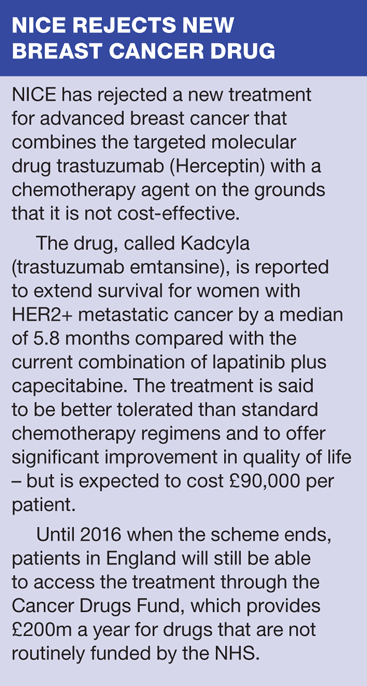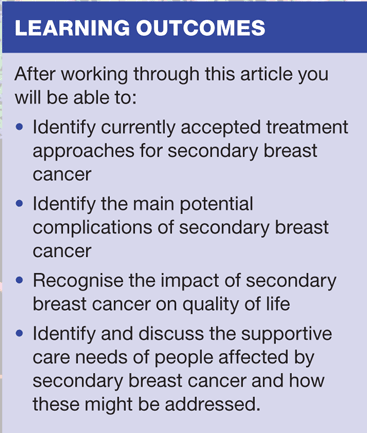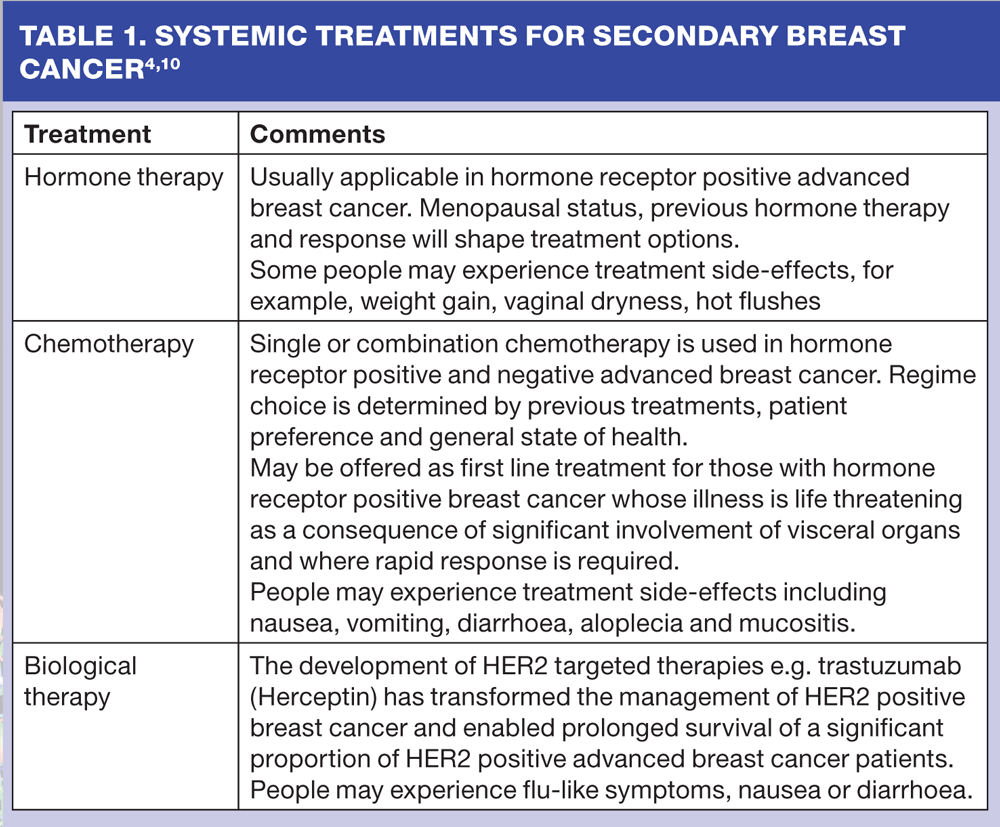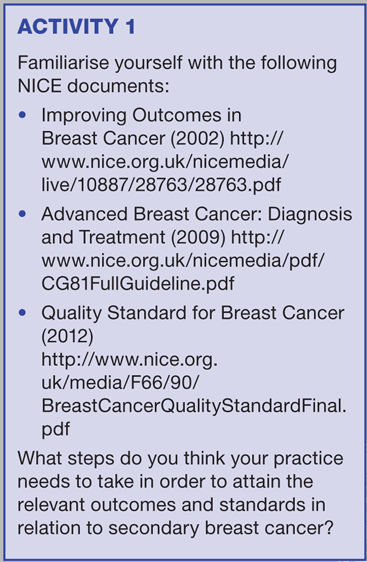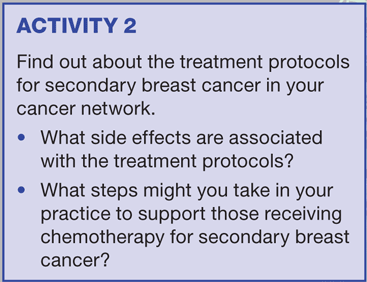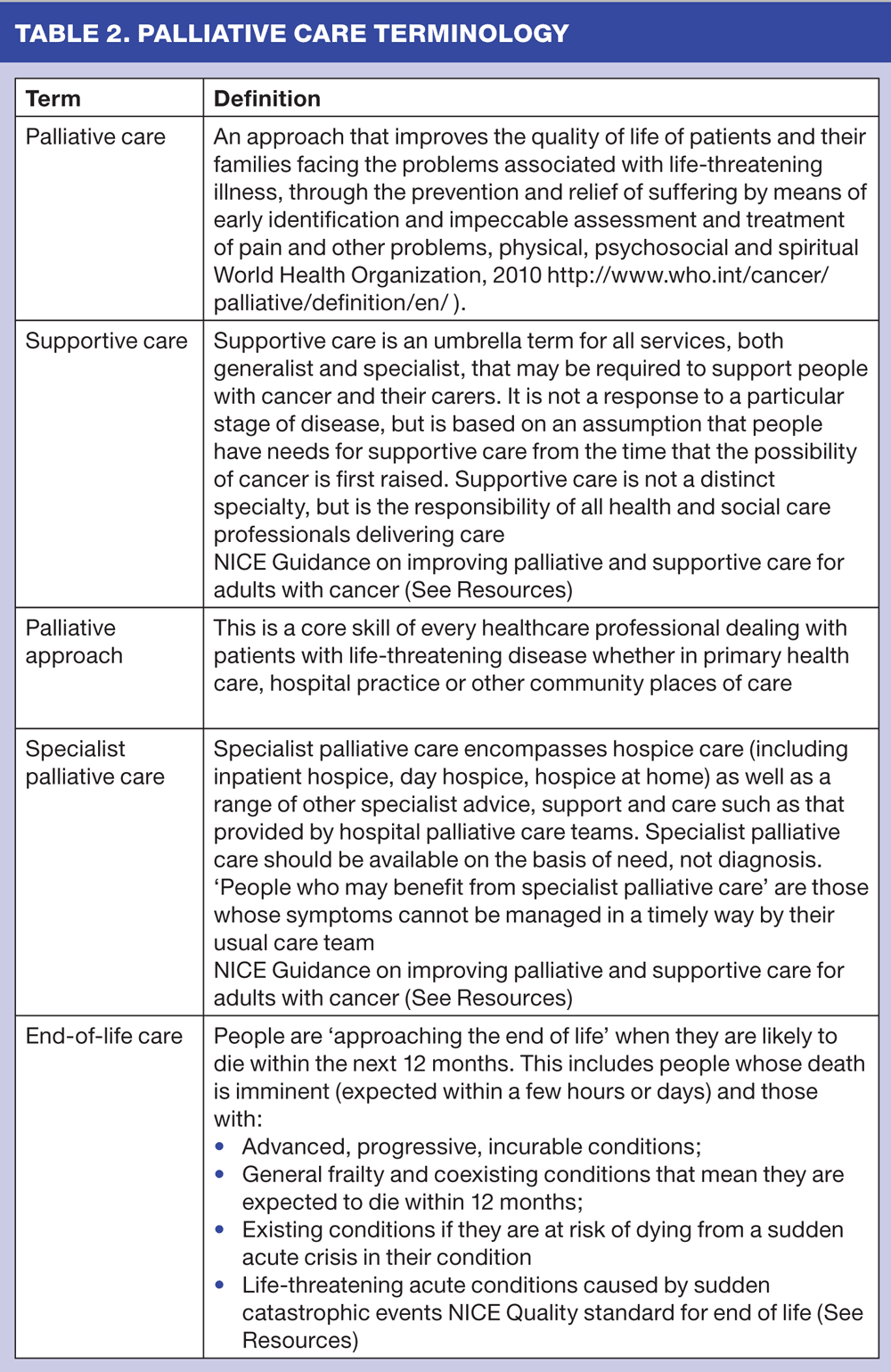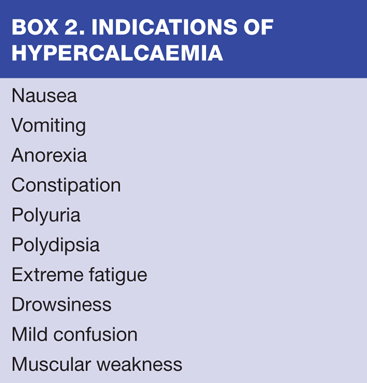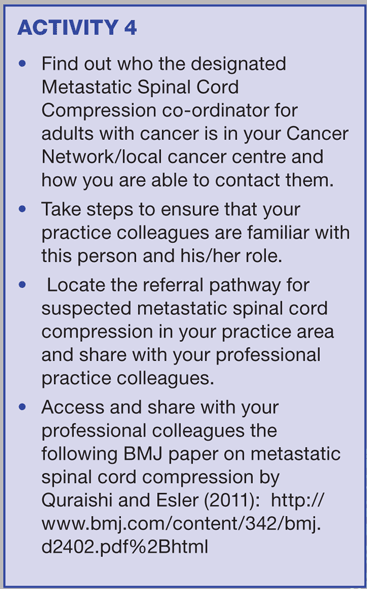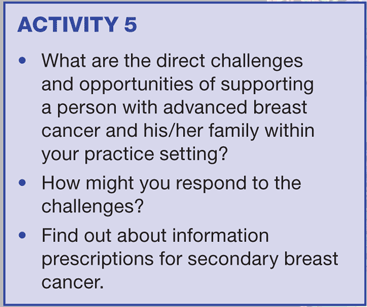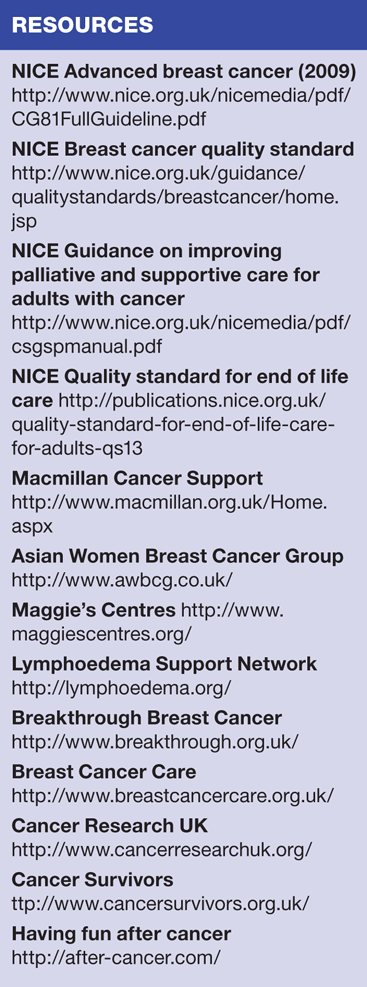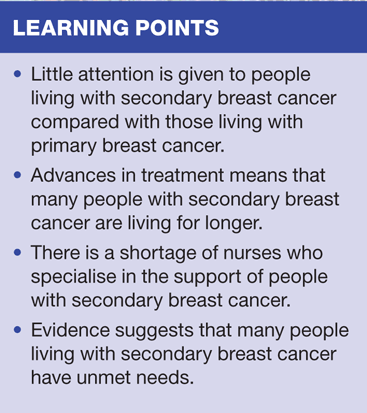
Secondary breast cancer: the role of primary care nurses
Tessa Watts
Tessa Watts
BA (Hons), MSc, RN, PGCE
Associate Professor
College of Human and Health Sciences
Swansea University
People with secondary breast cancer are living longer, yet many face considerable challenges and lack of supportive care — so it is vital that practice nurses are aware of their needs and how to meet them
Internationally, the prevalence of breast cancer, the most common form of invasive female cancer, is increasing.1 Treatment strategies for people living with secondary breast cancer have changed substantially in recent years. These developments are extremely positive, not least because of the increase in survival of many living with the illness. Yet, during their illness trajectory, many still face considerable challenges that significantly affect their quality of life. Sadly, care for these individuals, when compared with that offered to those with primary breast cancer, has been inadequate. Research indicates that people affected by secondary breast cancer have diverse unmet supportive care needs.
At a time when the health service is undergoing significant reform and the prevalence and survival time of secondary breast cancer is increasing it is vital that those of us who work in primary care are aware of and able to meet the challenges and needs of this patient group. This article aims to give you an overview of the key issues.
INCIDENCE
Breast cancer is currently the most frequent cancer affecting women in the UK, accounting for just under a third of new female cancer cases. In 2011, 50,285 people, mainly women (49, 936), were diagnosed with breast cancer in the UK.2 A small proportion of these people would have had secondary breast cancer at the time of their initial breast cancer diagnosis, but it is estimated that approximately a third of women who have been treated with curative intent will go on to develop secondary disease.3
The precise number of people living with secondary breast cancer in the UK is unknown since this data is not routinely collected,4 but it has been suggested that, given breast cancer's prevalence, as many as 100,000 people in the UK could be living with secondary disease.5
SURVIVAL
Secondary breast cancer, also referred to as metastatic or advanced breast cancer, refers to cancer which begins in the breast and then advances, either locally to the lymph nodes, skin or chest wall, or to distal sites — often the bones, lungs, liver and, on occasion, the brain - via the blood and lymphatic systems.6 The prognosis used to be poor, but the illness trajectory of secondary breast cancer has changed in recent years.
Population-based studies have shown that more people are living for longer with secondary breast cancer and increasingly it is thought of as a chronic, relapsing and remitting illness. Estimations of life expectancy from the point of diagnosis vary. Recent publications suggest median survival time of between 2 and 3 years.7,8 However, the range of overall survival is wide; some people live with secondary breast cancer for 10 to 15 years.9 This may in part be connected with enhanced treatment regimes.8
A significant amount of healthcare for those affected by breast cancer takes place in primary care.10 Many people with secondary breast cancer now receive treatments in community settings and some will require monitoring, e.g. interval blood tests. A number will have complex needs that demand co-ordinated, inter-professional collaboration. Understanding treatment options, their intent and effects, could enable practice nurses to offer additional support to patients, particularly when working in collaboration with GPs and specialist practitioners.
Such additional support could be invaluable to women with secondary breast cancer, for whom care has been described as inadequate in comparison to that offered to those with primary breast cancer. Although the charity Breast Cancer Care recommends that every person living with a diagnosis of secondary breast cancer must have access to a clinical nurse specialist with expertise in metastatic breast cancer,11 these nurses are in short supply.8
TREATMENT OPTIONS
Secondary breast cancer is a biologically diverse disease.5 Moreover, the biology of secondary cancer can differ from that of the primary cancer.4 Improved understanding of breast cancer biology has led to significant advances in and increased effectiveness of treatment. While it cannot be cured, a range of systemic treatment options is available, including chemotherapy, hormone and targeted biological therapies.(Table 1)
The aims of treatment are:
- To slow disease progression
- Control distressing symptoms, e.g. pain
- Limit treatment-associated toxicity, and
- Enhance quality of life for as long as possible.
The types of treatments offered depend on several different disease- and patient-related factors, including hormone receptor (HR) and human epidermal growth factor receptor-2 (HER2) status, availability of drugs, previous cancer treatments and individual patient factors such as any co-morbidities, menopausal status, circumstances and treatment preferences.10
UK guidelines on the treatment of secondary breast cancer were introduced in 2009,10 but concerns about the rigidity of NICE treatment guidelines, and their potential for a negative effect on individuals if inflexibly applied, have led to the development of supplementary guidance.4
Some treatments for secondary breast cancer can be associated with a degree of iatrogenic morbidity and achieving an appropriate balance of benefit to harm can be difficult. To enable people to live as well as possible with secondary breast cancer, supportive and palliative care should be offered alongside disease-modifying treatments. (Table 2)
COMPLICATIONS OF SECONDARY BREAST CANCER
The early detection and management of the complications of secondary breast cancer are important for enhancing the quality of life of those affected. It is therefore important that you are aware of frequently-occurring complications, such as:
- Uncontrolled local disease — e.g. fungating breast lesions
- Cancer-related fatigue
- Lymphoedema
- Treatment side effects, e.g. hot flushes, weight change, infection
- Skeletal complications as a consequence of bone metastases.
BONE METASTASES
The most frequent site of metastasis from breast cancer is bone.12 Bone metastases are associated with significant morbidity, restricted mobility and skeletal complications arising from bone weakness or disrupted calcium homeostasis, including:
- Bone pain
- Hypercalcaemia
- Pathological fractures
- Metastatic spinal cord or cauda equina compression.
The availability of a range of treatments that slow down underlying disease progression means that metastatic bone disease has become a chronic condition for many people, including those with advanced breast cancer.13 The treatment of bone metastases, however, is palliative, with the aims of preventing skeletal complications, easing pain and suffering, minimising disability and enhancing life quality.
Bone pain
Intractable bone pain is a significant problem for people with bone metastases. Pain is primarily nociceptive pain. However, it can become associated with neuropathic pain if the cancer invades or compresses a nerve.14 (Box 1) Many patients report moderate to severe, poorly localised pain — described as a deep ache or stabbing in nature, worse on movement and at night.
Treatment is aimed at immediate and longer term pain relief and may include systemic analgesia following the World Health Organization's analgesic ladder,15 single or multiple fractions of palliative radiotherapy,10 and either preventative or restorative surgery.
A Cochrane meta-analysis found some evidence of relief of bone pain among people with metastatic breast cancer who received bisphosphonates, but there is insufficient evidence to recommend bisphosphonates as a first line treatment.16
Hypercalcaemia
Hypercalcaemia is defined as a corrected serum calcium above 2.65mmol/l. It is a common, distressing, life-threatening metabolic condition that arises from the release of calcium from the bones. It affects between 10—30% of people with cancer and bone metastases are not always present.
Hypercalcaemia is not infrequent in advanced breast cancer. Indications of hypercalcaemia are non-specific.(Box 2) Symptoms are related to the absolute concentration and rate of rise of serum calcium and, as such, vary between individuals. Increasing dehydration can lead to further deterioration and even death. Symptom recognition is important because early detection and initiation of appropriate treatment can improve survival. The principle aims of treatment are to lower serum calcium levels by increasing renal excretion of calcium through hydration, and inhibiting pathologic osteoclastic bone resorption by means of medication. Treatment type is dependent on serum calcium levels and according to local protocols.
Pathological fractures
Pathological fractures occur when bone is destroyed by cancer cells. NICE guidelines recommend orthopaedic referral for individuals with long bone involvement to assess the benefits of preventative surgery to minimise the effect of a pathological fracture.10 Following a pathological fracture, surgery might be used to reconstruct or stabilise the fractured bone.17
Metastatic spinal cord compression
Spinal cord compression is a serious, emergency situation which requires immediate oncological assessment and treatment. Early diagnosis and prompt therapy are powerful predictors of outcome. Delays in both can lead to devastating neurological disability and significant reduction in quality of life.
NICE has produced specific guidelines for the management of metastatic spinal cord compression, which is defined as 'spinal cord or cauda equine compression by direct pressure and/or induction of vertebral collapse or instability by metastatic spread or direct extension of malignancy that threatens or causes neurological disability.'18
Any of the following symptoms are suggestive of spinal metastases and NICE guidelines recommend urgent discussion with the Cancer Centre Metastatic Spinal Cord Compression co-ordinator:
- Thoracic or spine pain
- Progressive lumbar spinal pain
- Severe unremitting lower spinal pain
- Spinal pain aggravated by straining
- Localised spinal tenderness
- Nocturnal spinal pain preventing sleep.
Indicators of metastatic spinal cord compression requiring immediate contact with the co-ordinator are:
- Neurological symptoms including radicular pain, any limb weakness, difficulty in walking, sensory loss or bladder or bowel dysfunction
- Neurological signs of spinal cord or cauda equina compression.18
IMPACT ON QUALITY OF LIFE
For those living with incurable illness the preservation of a good quality of life is paramount. The impact of the disease and its treatments on an individual's quality of life, and the provision of high quality, holistic care should be central considerations for health professionals.
Some clinical trials have sought to determine the influence of new treatment regimens for secondary breast cancer on individuals' quality of life,19 but more research is needed to provide insights into individuals' physical and psychological concerns, unmet needs and coping strategies. As yet there appear to be no published studies which have included men.
A 2012 UK, cross-sectional survey revealed that the overall quality of life described by women living with secondary breast cancer was poor.8 In contrast, a North American study found that the overall quality of life in women living with metastatic breast cancer for more than five years was 'quite good' — despite reports of substantial psychological distress, feelings of hopelessness, sadness and apprehension about their disease in a proportion of the subjects.19
In addition to psychological distress, participants in another 2013 study reported a range of physical symptoms, most often pain and fatigue and limitations in their physical, family and 'every day role' functioning.9
MEETING SUPPORTIVE CARE NEEDS
Although survival times are increasing, many people with secondary breast cancer live in the shadow of impending death and with uncertain, unpredictable illness trajectories. They also have to cope with numerous transitions as their general health and well-being ebbs and flows during phases of disease progression, acute symptom exacerbation, treatments and their side-effects, and recovery or relapse. It is therefore unsurprising that many have significant, complex and changing supportive care needs to manage their symptoms and side effects, to help them adapt and cope, and to maintain day-to-day function.20
Supportive care needs include dealing with the physical effects of cancer and its treatments, psychological, social and spiritual sequelae, timely access to appropriate health information, practical assistance and lifestyle, employment and financial advice.10 Moreover, supportive care needs change over time and vary between individuals.
A significant proportion of people with secondary breast cancer have unmet needs,21,22 particularly in relation to psychological support and information. A participant in a recently published study of the disease course of metastatic breast cancer commented that she felt she had been 'cast adrift with no health professional to support her'.23 And according to research from Breast Cancer Care, information provision for individuals with secondary breast cancer and their families was inadequate, particularly when compared with that received at the time of their original, primary diagnosis.11
With changes to the configuration of healthcare delivery and rising survival rates could mean that you will find yourself increasingly supporting these individuals as part of your everyday work. During routine contact you could offer support in a number of ways, including:
- Promoting and supporting health and wellbeing
- Monitoring for, and promoting the early detection of, psychosocial distress
- Providing relevant, clear, up-to-date information, e.g. information about local support and self-help groups, voluntary sector services, telephone helplines, Internet forums
- Signposting people to information and to their named keyworker.
CONCLUSION
The increasing prevalence of secondary breast cancer coupled with lengthening survival and new and emerging treatment regimes herald new challenges for practice nurses. To offer effective and timely care, practice nurses need to understand illness trajectories in secondary breast cancer, treatments and complications, and the particular needs of those affected. This could be stimulating, rewarding work of enormous benefit to patients and their families.
REFERENCES
1. World Health Organization. Fact Sheets: Cancer 2012; http://www.who.int/mediacentre/factsheets/fs297/en/
2. Cancer Research UK — Cancer Incidence and Mortality rates in the UK 2011 (Summary) http://publications.cancerresearchuk.org/publicationformat/data_tables/dtincmortrates.html
3. Warren M. Uncertainty, lack of control and emotional functioning in women with metastatic breast cancer: a review and secondary analysis of the literature using the critical appraisal technique. Eur J Cancer Care 2010; 19: 564-574.
4. Coleman RE, Bertelli G, Beaumont T et al. UK guidance document: Treatment of metastatic breast cancer. Clin Oncol 2011; 24: 169-176.
5. Johnston SRD. Living with secondary breast cancer: coping with an uncertain future with unmet needs. Eur J Cancer Care 2010; 19: 561-563.
6. Warren D, Mackie D. Co-ordination of supportive care needs in metastatic breast cancer. Cancer Nurs Prac 2014; 13: 23-27.
7. Cardoso F, Costa A, Norton L et al. 1st International consensus guidelines for advanced breast cancer (ABC 1) The Breast 2012; 21: 242-252.
8. Reed E, Simmonds P, Haviland J et al. Quality of life and experience of care in women with metastatic breast cancer: a cross—sectional survey. J Pain Symptom Man 2012; 43: 747-758.
9. Mosher CE, Johnson C, Dickler M et al. Living with metastatic breast cancer: a qualitative analysis of physical, psychological and social sequelae. Breast J 2013; 3: 285-292.
10. National Institute for Health and Clinical Excellence. Advanced Breast Cancer: Diagnosis and Treatment. Clinical Guideline 81. 2009; National Institute for Health and Clinical Excellence, London.
11. Breast Cancer Care. Improving the care of people with metastatic breast cancer. Final Report. 2008. http://www.breastcancercare.org.uk/upload/pdf/BCC_MainTaskforce_Report_AD3294_V5.pdf
12. Cardoso F, Bischoff J, Brain E et al. A review of the treatment of endocrine responsive metastatic breast cancer in postmenopausal women. Cancer Treat Reviews 2013; 39: 457-465.
13. Li BT, Wong M, Pavlakis N. Treatment and prevention of bone metastases from breast cancer: a comprehensive review of evidence for clinical practice. J Clin Med 2014; 3: 1-24.
14. Coleman R. Clinical features of metastatic bone disease and risk of skeletal morbidity. Clinical Cancer Res 2006; 12: 6243s — 6249s.
15. World Health Organisation. World Health Organisation's Cancer Pain Ladder for Adults. 2014 http://www.who.int/cancer/palliative/painladder/en/
16. Wong R, Wiffen P. Bisphosphonates for the relief of pain secondary to bone metastases. Cochrane Database Syst Rev 2002; doi:10.1002/14651858.CD002068.
17. Beaumont T, Leadbeater M. Treatment and care of patients with metastatic breast cancer. Nurs Standard 2011; 25: 48-56.
18. National Institute for Health and Clinical Excellence. Metastatic Spinal Cord Compression. Diagnosis and Management of Adults at risk of and with Metastatic Spinal Cord Compression. 2008; National Institute for Health and Clinical Excellence, London.
19. Meisel Jl, Domachek Sm, Vonderheide RH et al. Quality of life in long-term survivors of metastatic breast cancer. Clin Breast Cancer 2012; 129(2):119-126.
20. Aranda S, Schofield P, Weih L et al. Mapping the quality of life and unmet needs of urban women with metastatic breast cancer. Eur J Cancer Care 2005; 14: 211-222.
21. Hamer V. Advanced breast cancer: 'here and now' B J Nurs 2013; 22:990.
22. Aranda S, Schofield P, Weih L et al. Meeting the support and information needs of women with advanced breast cancer: a randomised controlled trial, B J Cancer 2006; 95: 667-673.
23. Reed E, Corner J. Defining the illness trajectory of metastatic breast cancer. BMJ Support Palliat Care 2013; 0: 1-8 doi:10.1136/bmjspcare-2012-000415
Related articles
View all Articles
